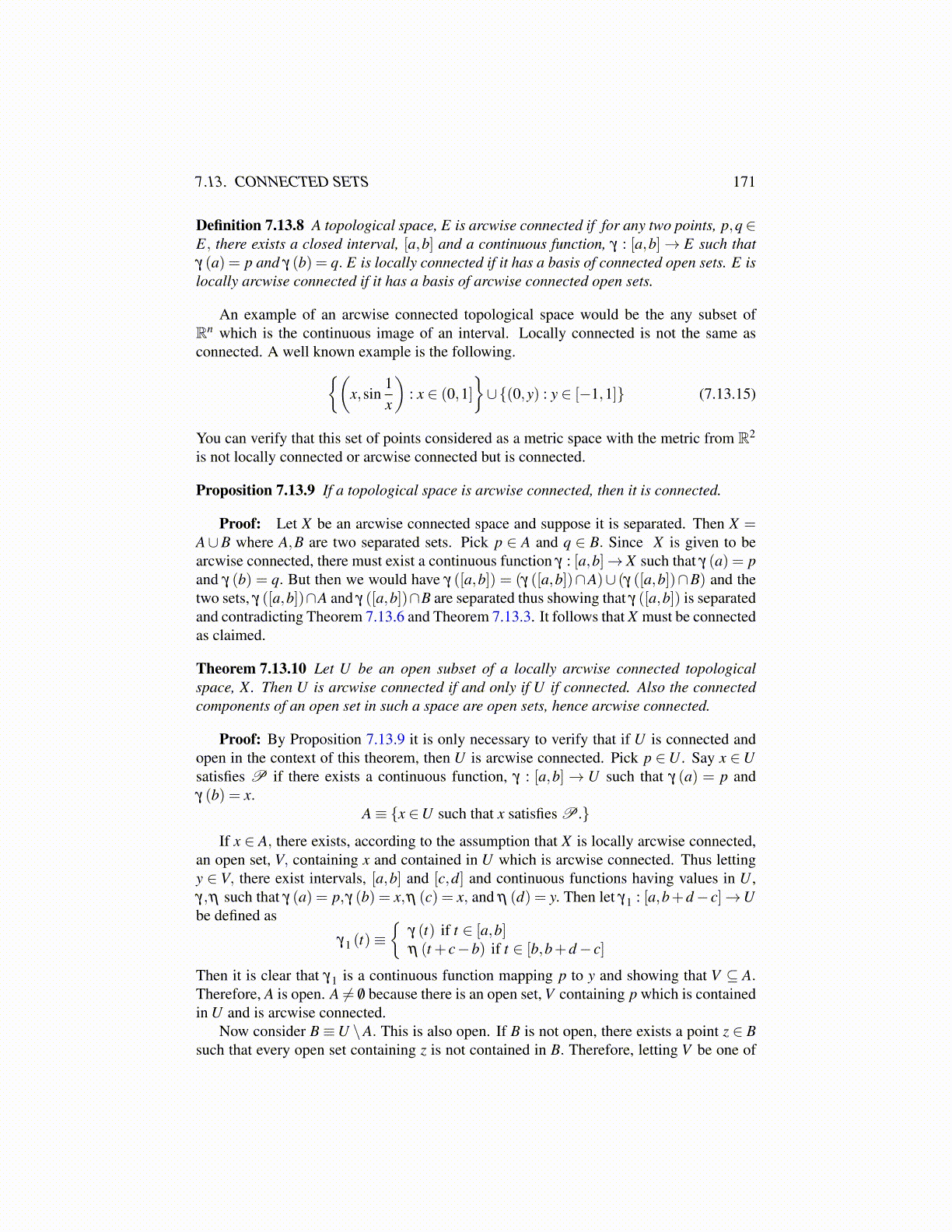
7.13. CONNECTED SETS 171
Definition 7.13.8 A topological space, E is arcwise connected if for any two points, p,q∈E, there exists a closed interval, [a,b] and a continuous function, γ : [a,b]→ E such thatγ (a) = p and γ (b) = q. E is locally connected if it has a basis of connected open sets. E islocally arcwise connected if it has a basis of arcwise connected open sets.
An example of an arcwise connected topological space would be the any subset ofRn which is the continuous image of an interval. Locally connected is not the same asconnected. A well known example is the following.{(
x,sin1x
): x ∈ (0,1]
}∪{(0,y) : y ∈ [−1,1]} (7.13.15)
You can verify that this set of points considered as a metric space with the metric from R2
is not locally connected or arcwise connected but is connected.
Proposition 7.13.9 If a topological space is arcwise connected, then it is connected.
Proof: Let X be an arcwise connected space and suppose it is separated. Then X =A∪B where A,B are two separated sets. Pick p ∈ A and q ∈ B. Since X is given to bearcwise connected, there must exist a continuous function γ : [a,b]→ X such that γ (a) = pand γ (b) = q. But then we would have γ ([a,b]) = (γ ([a,b])∩A)∪ (γ ([a,b])∩B) and thetwo sets, γ ([a,b])∩A and γ ([a,b])∩B are separated thus showing that γ ([a,b]) is separatedand contradicting Theorem 7.13.6 and Theorem 7.13.3. It follows that X must be connectedas claimed.
Theorem 7.13.10 Let U be an open subset of a locally arcwise connected topologicalspace, X. Then U is arcwise connected if and only if U if connected. Also the connectedcomponents of an open set in such a space are open sets, hence arcwise connected.
Proof: By Proposition 7.13.9 it is only necessary to verify that if U is connected andopen in the context of this theorem, then U is arcwise connected. Pick p ∈U . Say x ∈Usatisfies P if there exists a continuous function, γ : [a,b]→ U such that γ (a) = p andγ (b) = x.
A≡ {x ∈U such that x satisfies P .}
If x ∈ A, there exists, according to the assumption that X is locally arcwise connected,an open set, V, containing x and contained in U which is arcwise connected. Thus lettingy ∈ V, there exist intervals, [a,b] and [c,d] and continuous functions having values in U ,γ,η such that γ (a) = p,γ (b) = x,η (c) = x, and η (d) = y. Then let γ1 : [a,b+d− c]→Ube defined as
γ1 (t)≡{
γ (t) if t ∈ [a,b]η (t + c−b) if t ∈ [b,b+d− c]
Then it is clear that γ1 is a continuous function mapping p to y and showing that V ⊆ A.Therefore, A is open. A ̸= /0 because there is an open set, V containing p which is containedin U and is arcwise connected.
Now consider B ≡U \A. This is also open. If B is not open, there exists a point z ∈ Bsuch that every open set containing z is not contained in B. Therefore, letting V be one of